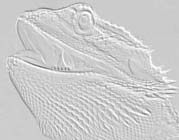 |
 |
|||
 |
||||
|
In general, metabolic bone disease is the weakening of the bone caused by an imbalance in vitamin D3, calcium, and phosphorus. Several foods, which have a high calcium content, such as spinach, carrots, collards, chards and other thick leafy greens, also contain oxalates, which bind to calcium. When foods high in oxalates are eaten by a beardie, the oxalates attack the calcium and make it useless in their body. Vitamin D3, calcium, and phosphorus interact together to perform a number of functions besides bone growth and maintenance, including muscle contractions and blood coagulation. Too much phosphorus can throw this balance off, as can too much or too little vitamin D3 or too little access to UVB light. As the dangers of calcium deficiency become more widely known, there is also the risk of too much calcium (hypercalcemia), which is rare. Signs of metabolic bone disease include hard knobs in the long bones of the legs, bumps along the vertebral column of the back and tail, and softening or hard swelling of the lower jaw. Regular physical exams are important as these bumps may be felt before they can usually be seen. Visible signs of moderate to severe MBD include jerky movements when walking, repeated tremors, twitches, or spasms in the limbs and muscles of the legs and toes when at rest or after exercise, and shakiness when being held. More advanced cases of MBD include all the above signs plus constipation, anorexia, and fractured bones. Severely deficient Beardies tend to be lethargic and may only be able to drag themselves along the ground. There are several treatment options available for Beardies suffering from MBD. Moderate to severe cases of MBD require the proper diet, temperatures, and UVB as well as a more powerful calcium supplement than those found in pet stores. Oral administration of calcium glubionate (1cc/kg) or injections of calcium lactate (250 mg/kg) or calcium gluconate (100 mg/kg) are generally prescribed by veterinarians. Studies have shown a faster recovery with calcitonin (Calcimar, Miacalcin, 50 IU/kg in the front leg, repeated once a week for two weeks) when it is administered to Beardies who have a normal serum calcium level. A blood test by your vet will determine your Beardies serum calcium level. The use of calcitonin before normal levels have been established, may cause hypocalcemic tetany and death. In mild cases of MBD, where the signs are felt or just barely visible, can be treated by correcting the diet and environment. The proper amount of UVB light is important and necessary in treating and preventing MBD. Vets have prescribed the use of self-balasted mercury vapor UVB/heat bulbs as part of the treatment for MBD. These bulbs have a UVB element and a heat element, all rolled into one. I have these bulbs in all of my Beardie enclosures and am astonished with the results. After a few weeks of installing the new bulbs, I noticed a major color enhancement in all of my beardies! Along with proper day and night temperature gradients and a nighttime dark period, proper diet is essential to recovery. During recovery, your beardie should be fed calcium-rich, nutrient dense foods such as squashes, green beans, mustard greens, dandelions, escarole, and papaya. The food should be supplemented with additional calcium and a multi-vitamin formulated for reptiles. See my Nutrition page for more info on calcium rich foods.
|
||||
| This information should be used only as a reference tool and should not be used in place of vet assistance. My views and opinions are the result of hours of dedicated research. But remember, I am not a professional. If you have a sick beardie and don't know what to do, don't play God, take him to the vet immediately. | ||||
|
Copyright
© Beautiful Dragons. All Rights Reserved.
This website may not be copied or reproduced without my permission. |
||||